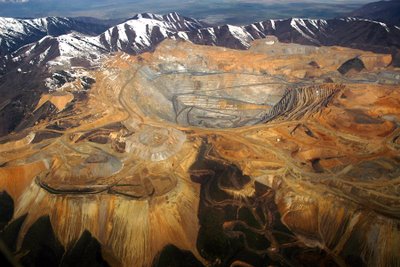 [Image: Bingham Canyon, Utah, photographed by the Center for Land Use Interpretation].
[Image: Bingham Canyon, Utah, photographed by the Center for Land Use Interpretation].This text is all via John McPhee: "The nails that hold the place together come from the Mesabi Range. His downspouts are covered with zinc that was probably taken out of the ground in Canada. The tungsten in his light bulbs may have been mined in Bishop, California. The chrome on his refrigerator door probably came from Rhodesia or Turkey. His television set almost certainly contains cobalt from the Congo. He uses aluminum from Jamaica, maybe Surinam; silver from Mexico or Peru; tin – it's still in tin cans – from Bolivia, Malaya, Nigeria. People seldom stop to think that all these things – planes in the air, cars on the road, Sierra Club cups – once, somewhere, were rock. Our whole economy – our way of doing things. Oh, gad! I haven't even mentioned minerals like manganese and sulphur. You won't make steel without them. You can't make paper without sulphur..."
Rearranging planets into TVs. Producing objects from geology.
No comments:
Post a Comment